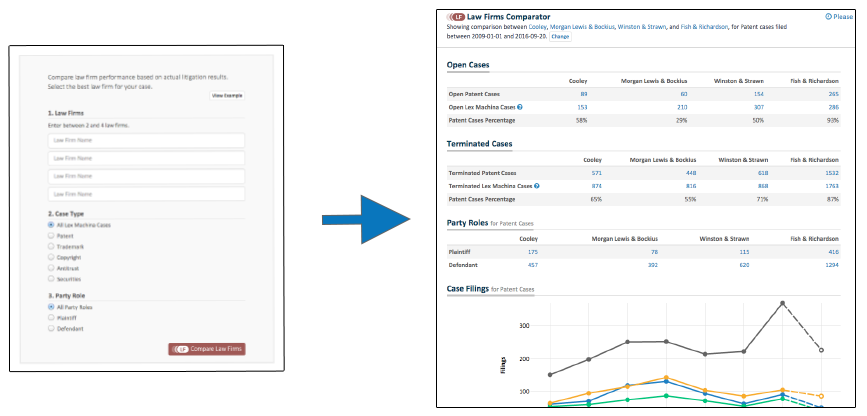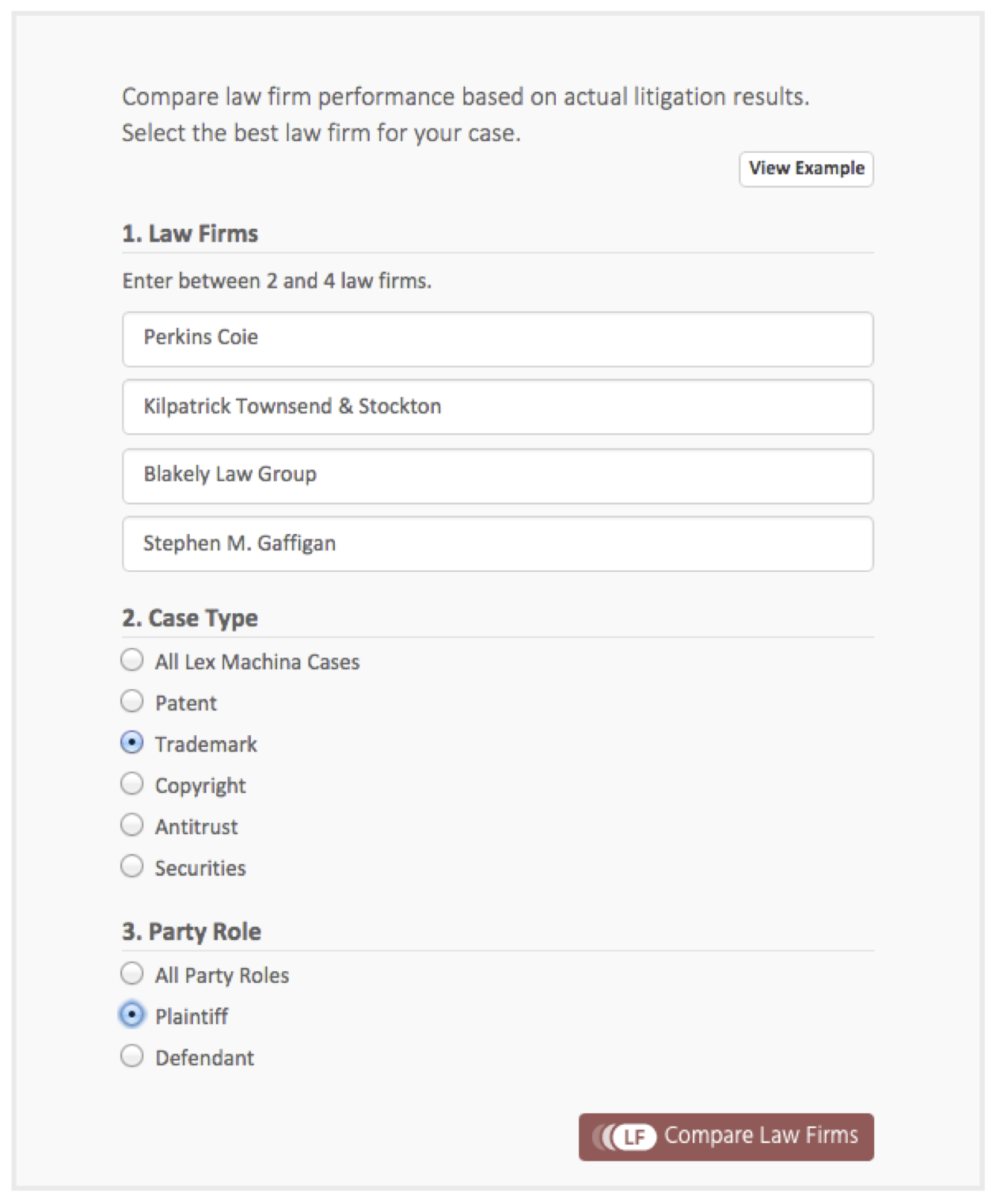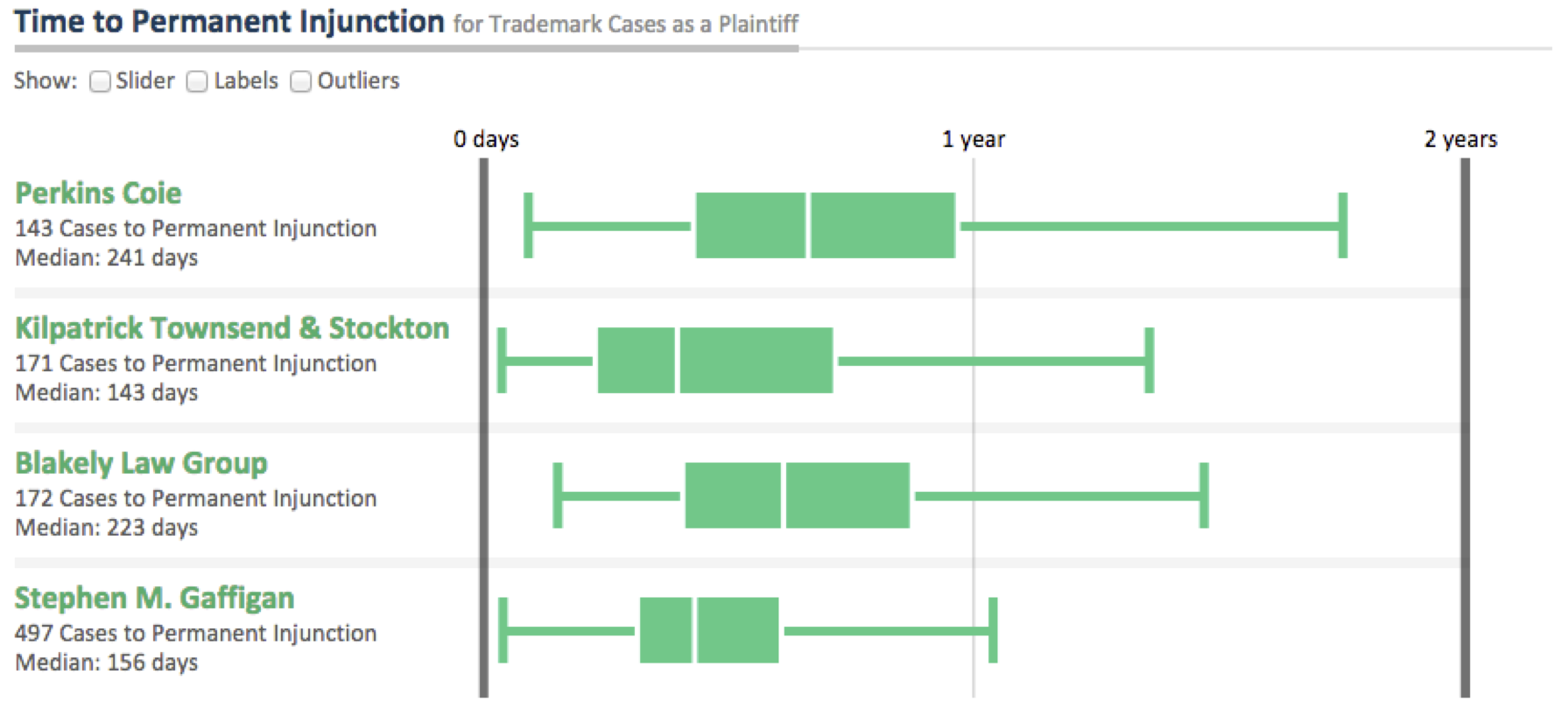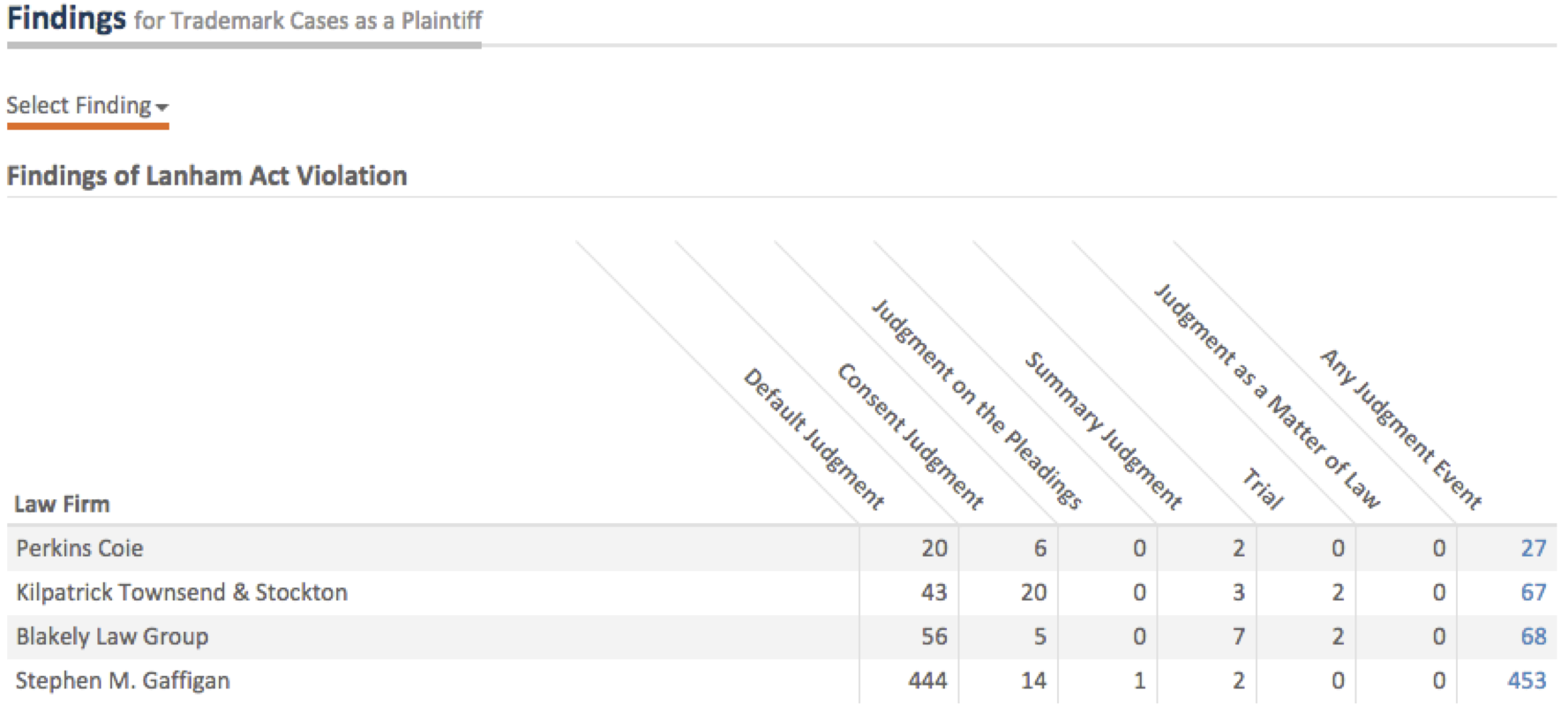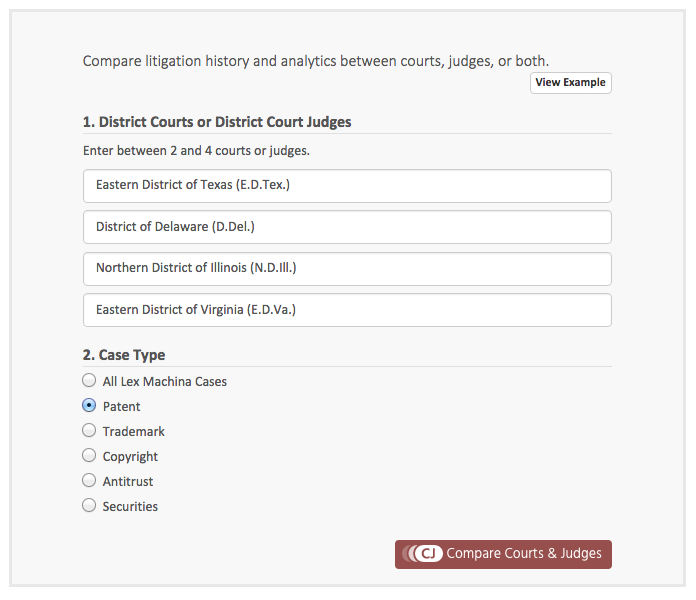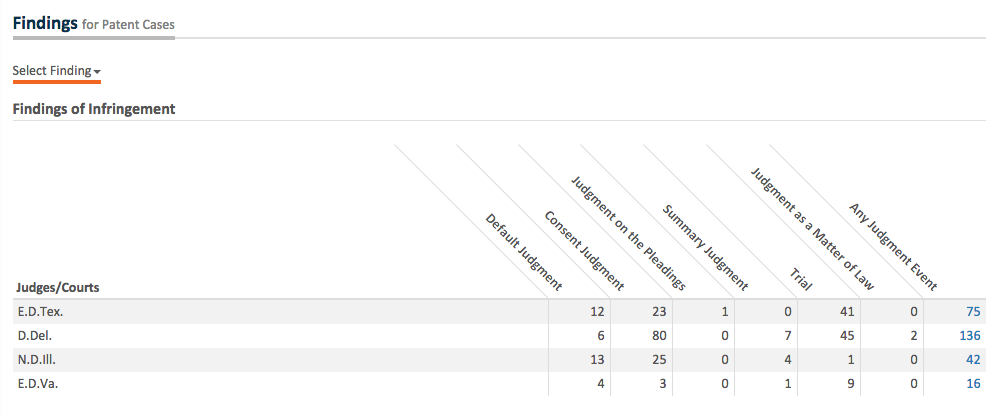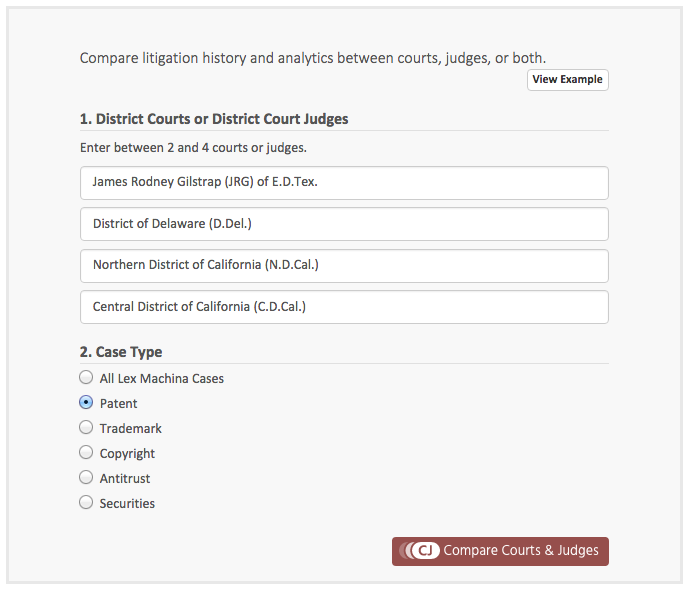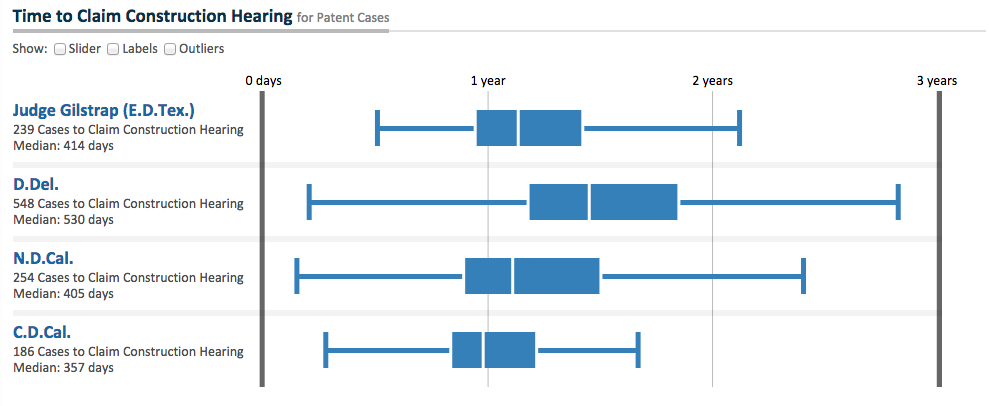Lex Machina’s new Comparator Apps, launched earlier today, make it easier than ever before to analyze up to four different courts, judges, or law firms side-by-side, on a single page, and all within seconds.
The Law Firms Comparator simplifies the business decision of which law firm to hire, helping in-house counsel compare key factors like win-rate, previous experience, case timing, and damages history across the different law firms. Lawyers at firms can easily size up their competition, and those in business development can find new ways to tout their firm’s success.
For those more involved in the practice of law, the Courts & Judges Comparator helps lawyers make informed decisions among different judicial districts. Plaintiffs can assess how their chances of success vary across districts, and defendants can determine how transfer to different venues compares with remaining before the judge they have.
This blog post will explore three examples that demonstrate how these apps can help lawyers make more effective decisions when hiring outside counsel or selecting a venue.
1. The business of law: company evaluates outside counsel (or counsel evaluating competition)
Companies looking to “lawyer up” can now easily compare the records of different firms along the aspects of litigation that matter most to them. Used in combination with proposed budgets from the firms competing for business, the Law Firm Comparator app lets companies quickly determine the relative value proposition for each firm, helping to ensure that best result per dollar is achieved.
Consider a company looking for new counsel to handle for trademark enforcement. The company has already identified some top trademark firms to compare, including Perkins Coie, Kilpatrick Townsend & Stockton, the Blakely Law Group, and Stephen M. Gaffigan. Starting the process is as simple as typing in these names.
The Law Firms Comparator app has a menu of analytics similar to the Courts & Judges app, and includes:
- Open cases
- Terminated cases
- Party role breakdown
- Timing to events (motion to dismiss, claim construction, summary judgment, trial, termination)
- Case resolutions
- Damages
- Remedies
- Findings
Looking at terminated cases quickly establishes that all firms are experienced with trademark cases. However, if you’re looking to include a patent or copyright claim, the larger firms of Perkins and Kilpatrick do more work outside trademark.
For many companies looking to enforce their marks, the point of the litigation is to get the infringement to stop – and that means an injunction. For these organizations, therefore, the time to injunction for each firm should be an important factor. Although Kilpatrick has a slightly faster median time to injunction than Stephen Gaffigan, his cases more consistently result in a fast injunction.
Turning to case resolutions, Kilpatrick slightly outperforms Perkins, but Gaffigan has an very high 93% of cases resulting in claimant win.
Turning to the findings, it becomes apparent that Gaffigan’s win rate comes from the default judgments, of which there are many. Unlike the other firms, he has not taken cases to trial recently. the choice of firm may well depend on the business goals of the trademark enforcement and the likelihood of winding up at trial.
Of course the Law Firm Comparator app is also integrated into Lex Machina’s platform so it’s simple to explore these comparisons in more depth – the client list of any of these firms is only two clicks away if you want to peruse it for potential conflicts or for a personal recommendation.
2. The practice of law: plaintiff chooses where to sue
Plaintiffs have the choice of venue and Lex Machina makes it incredibly easy to compare the key metrics of different districts.
Take, for example, a patent plaintiff company evaluating four different districts in which they can likely get jurisdiction (the Eastern District of Texas, the District of Delaware, the Northern District of Illinois, and the Eastern District of Virginia) as candidates for their next case. Simply enter those districts:
Lex Machina then provides a detailed comparison of litigation metrics for each district, including open cases, terminated cases, and case filings, as well as time to events like motion to dismiss, claim construction, summary judgment, trial, and termination. Data on case outcomes include resolutions, damages, remedies, and findings.
A few of these metrics are particularly helpful to our hypothetical plaintiff. First, it is plain that plaintiffs previously have chosen the Eastern District of Texas (E.D.Tex.) or the District of Delaware (D.Del.) in recent years. But our plaintiff wonders if the other data supports those choices….
For a plaintiff, a longer time to trial can mean that more of the case is spent in discovery – this yields leverage over the defendant (who faces more time and expense). The longer discovery can also allow the facts of the case to develop and may present more chances for settlement.
A comparative view of the four districts reveals that the Northern District of Illinois (N.D.Ill.) has the longest time to trial, followed by E.D.Tex. and D.Del., which are rather similar. However, because the data for N.D.Ill. is based on a relatively small number of cases (11) with lots of variation, it may not be the best predictor.
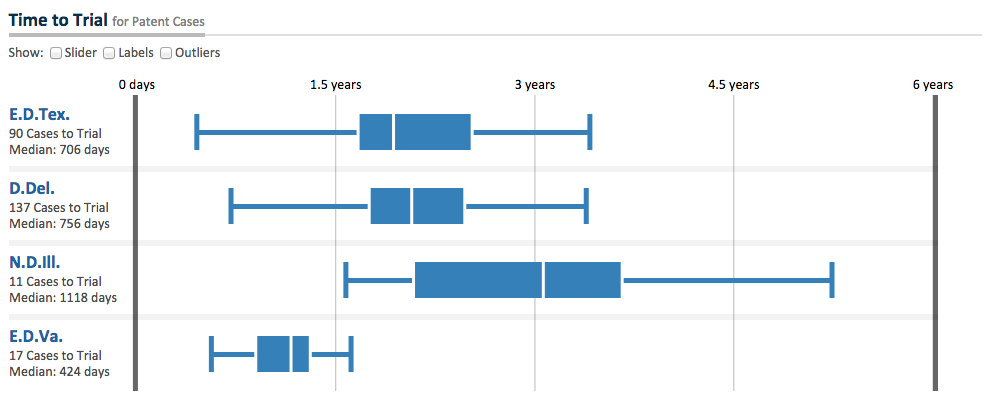
Among the most important metrics, however, is the case resolution, which summarizes how previous cases have ended. Comparing the top two rows (representing plaintiff wins and defendant wins) for each district, we see that, despite it’s longer median time to trial, N.D.Ill. has resolved the highest percentage of cases for defendants among these four districts. Only D.Del. has resolved more cases for plaintiff than defendant.
Want to get more granular? All the blue numbers in these charts are clickable in the apps, making it easy to drill down to the actual cases.
Findings of infringement among the districts support a similar conclusion: Delaware has seen the most findings of infringement. Even discounting the large number of consent judgments, Delaware’s 45 trials outnumber E.D.Tex.’s 41 trials despite the greater number of cases filed there – another good reason to file in Delaware.
Based on the similar time to trial between E.D.Tex. and D.Del. and the more advantageous resolutions and findings in D.Del., Delaware is likely to be the best district for our plaintiff’s case.
In a manner of minutes, counsel has been able to visualize how these districts measure up to each other on four key data points and to make a reasoned, facts-based decision on venue selection.
What can now be done in a few clicks would, before the advent of Legal Analytics, have required a weeks of time and more resources than most could devote to a decision like this, despite its clear importance.
3. Practice of Law: defendant considers whether and where to transfer
While plaintiffs choose where a case is first filed, defendants have the option to transfer. Often, jurisdiction may exist in several districts, giving defendants a choice of their own. The Courts & Judges Comparator App lets defendants model this decision, comparing the merits and disadvantages of up to three different transfer venues.
For example, a patent defendant may assigned to Judge Rodney Gilstrap in the E.D.Tex. If good jurisdiction also likely exists in the Northern District of California, the Central District of California, and the District of Delaware, which is the best bet? Again, all we have to do is enter the names of judges or districts in the app to yield an instant comparison on several data points.
For a defendant, reaching claim construction quickly and having a chance to get out of the case on summary judgment are important factors. A quick look at the graph below reveals that times to construction hearing and summary hearing are faster staying before Judge Gilstrap than in Delaware, but the California districts are better still, with the Central District of California being the fastest.
For the defendant, it’s also important to consider a worst-case-scenario and consider the damages awarded by the different districts – A glance at the table below shows that N.D. Cal. has awarded more damages than C.D.Cal. in recent cases.
A defendant may also win by invalidating a patent. If a defendant’s case turns on prior art or some other question of invalidity, then the N.D.Cal. may be worth more attention: it’s granted more findings of invalidity than the other districts, especially in trial and through judgments as a matter of law.
Again, with a few clicks, a defendant can easily and quickly evaluate options based on real litigation data and arrive at a reasoned decision on whether to pursue a transfer of venue.
In conclusion, the Comparator apps make it easy to compare the most important players in litigation on the metrics that matter the most, helping counsel effectively navigate a choice of judicial districts (and judges) and helping companies informed decisions about which firm to hire for a case. What used to require weeks of work to assemble now resides in single tab. The information now available in a single window from the Comparator apps represents work that would have taken weeks to compile and digest manually.
